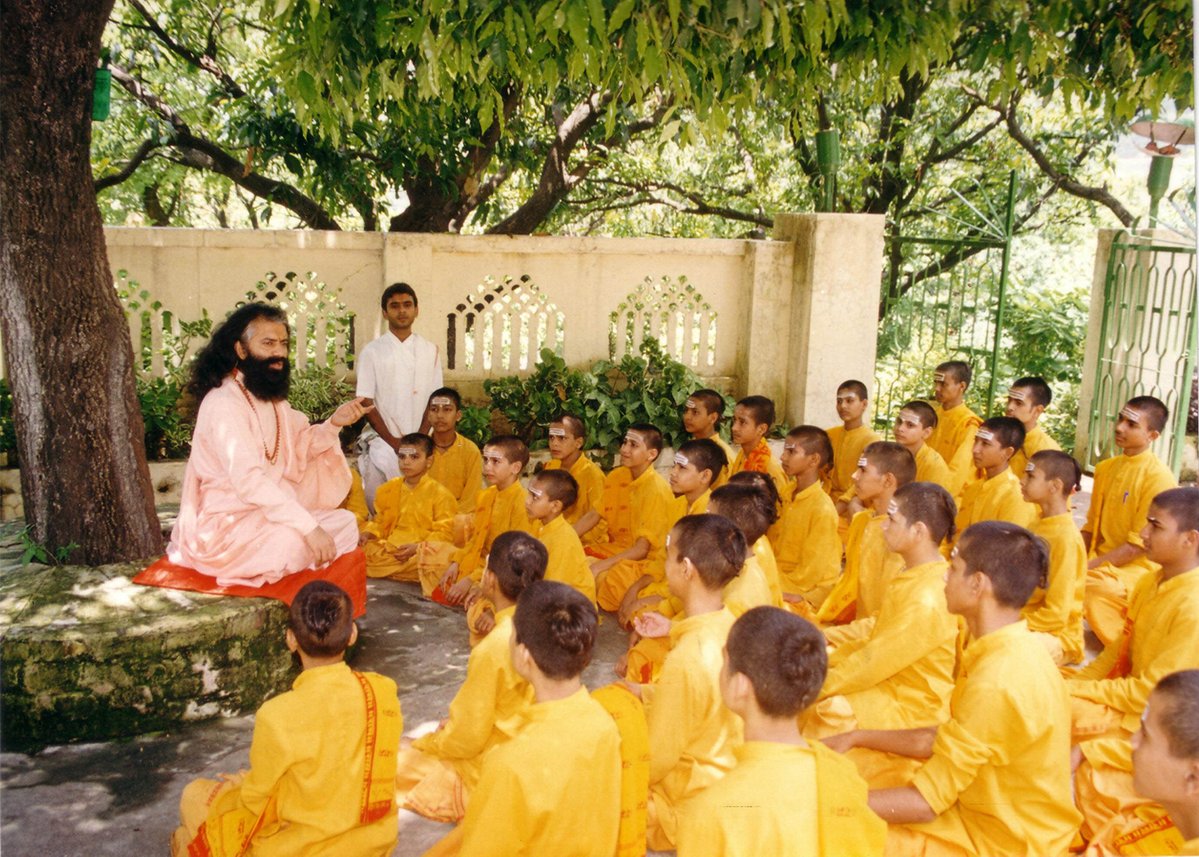|
Oakland Ashram
The Siddha Yoga Ashram in Oakland (or Oakland Ashram) is a Siddha Yoga retreat site in the Golden Gate neighborhood of Oakland, California, on the east side of San Francisco Bay. It was the second ashram established by the Indian meditation master Swami Muktananda, the first being Sri Gurudev Ashram, now Gurudev Siddha Peeth, in Ganeshpuri, India. History When Swami Muktananda was on his second world tour in 1975, it became clear that he needed a permanent center in the United States where people could spend time with him and do the Siddha Yoga practices of chanting, meditation, and seva, or selfless service. His devotees acquired Hotel Stanford in a depressed part of Oakland and transformed it into an ashram. The Oakland Ashram is where Swami Muktananda (also known as "Baba") first began teaching his devotees about the ancient philosophical teachings of Kashmir Shaivism.Meditation revolution p.96 It is also where he developed Siddha Yoga Dham Associates and the other organizati ... [...More Info...] [...Related Items...] OR: [Wikipedia] [Google] [Baidu] |
Siddha Yoga
Siddha Yoga is a spiritual path founded by Swami Muktananda (1908–1982). The organization states in its literature that the Siddha Yoga tradition is "based mainly on eastern philosophies". It also states that it "draws many of its teachings from the Indian yogic texts of Vedanta and Kashmir Shaivism, the Bhagavad Gita and the poet-saints." The present head of Siddha Yoga is Gurumayi Chidvilasananda. Ashrams and meditation centers provide places to learn and practice Siddha Yoga. The two main ashrams are: Gurudev Siddha Peeth in Ganeshpuri, India, and Shree Muktananda Ashram in upstate New York. There are meditation centers in a number of countries, including India, the United States, Australia, United Kingdom, France, Belgium, Germany, Italy, Canada, Mexico, Brazil and Japan. Etymology "Siddha Yoga" ("perfect" or "perfected" yoga) is a Sanskrit term adopted by Muktananda to describe the path of self-realization that he embarked on under the guidance of his spiritual teac ... [...More Info...] [...Related Items...] OR: [Wikipedia] [Google] [Baidu] |
Golden Gate, Oakland, California
The Golden Gate neighborhood of Oakland, California is located in the northwest corner of the city, east of Emeryville and south of Berkeley. It includes the Golden Gate Shopping District, the stretch of San Pablo Avenue between 53rd Street on the south, and the Oakland-Berkeley border at 67th Street to the north. The neighborhood includes the area from a few blocks west of San Pablo Avenue (the Emeryville border) to Adeline Street on the east. The district includes cafes and arts establishments. History The area was inhabited by the Huchiun band of the Ohlone people, then was part of the Rancho San Antonio grant, which was split up following the Treaty of Guadalupe Hidalgo. Charles Alexander Klinkner built 75 homes in the area and called it Klinknerville, established in 1885. A Klinknerville post office was established in 1887. The name was changed to Golden Gate in 1888. The town was annexed to Oakland in 1897. The Golden Gate branch of the Oakland Library opened in 1918 ... [...More Info...] [...Related Items...] OR: [Wikipedia] [Google] [Baidu] |
Oakland
Oakland is the largest city and the county seat of Alameda County, California, United States. A major West Coast port, Oakland is the largest city in the East Bay region of the San Francisco Bay Area, the third largest city overall in the Bay Area and the eighth most populated city in California. With a population of 440,646 in 2020, it serves as the Bay Area's trade center and economic engine: the Port of Oakland is the busiest port in Northern California, and the fifth busiest in the United States of America. An act to incorporate the city was passed on May 4, 1852, and incorporation was later approved on March 25, 1854. Oakland is a charter city. Oakland's territory covers what was once a mosaic of California coastal terrace prairie, oak woodland, and north coastal scrub. In the late 18th century, it became part of a large ''rancho'' grant in the colony of New Spain. Its land served as a resource when its hillside oak and redwood timber were logged to build San Francisc ... [...More Info...] [...Related Items...] OR: [Wikipedia] [Google] [Baidu] |
California
California is a U.S. state, state in the Western United States, located along the West Coast of the United States, Pacific Coast. With nearly 39.2million residents across a total area of approximately , it is the List of states and territories of the United States by population, most populous U.S. state and the List of U.S. states and territories by area, 3rd largest by area. It is also the most populated Administrative division, subnational entity in North America and the 34th most populous in the world. The Greater Los Angeles area and the San Francisco Bay Area are the nation's second and fifth most populous Statistical area (United States), urban regions respectively, with the former having more than 18.7million residents and the latter having over 9.6million. Sacramento, California, Sacramento is the state's capital, while Los Angeles is the List of largest California cities by population, most populous city in the state and the List of United States cities by population, ... [...More Info...] [...Related Items...] OR: [Wikipedia] [Google] [Baidu] |
Ashram
An ashram ( sa, आश्रम, ) is a spiritual hermitage or a monastery A monastery is a building or complex of buildings comprising the domestic quarters and workplaces of monastics, monks or nuns, whether living in communities or alone (hermits). A monastery generally includes a place reserved for prayer which ... in Indian religions. Etymology The Sanskrit noun is a thematic nominal derivative from the root 'toil' (< Proto-Indo-European, PIE *''ḱremh2'') with the prefix 'towards.' An ashram is a place where one strives towards a goal in a disciplined manner. Such a goal could be ascetic, spirituality, spiritual, yogic or any other. Overview  An ashram wo ...
An ashram wo ...
[...More Info...] [...Related Items...] OR: [Wikipedia] [Google] [Baidu] |
Muktananda
Swami Muktananda Paramahamsa (16 May 1908 – 2 October 1982), born Krishna Rai, was a yoga guru, the founder of Siddha Yoga. He was a disciple of Bhagavan Nityananda. He wrote books on the subjects of Kundalini Shakti, Vedanta, and Kashmir Shaivism, including a spiritual autobiography entitled ''The Play of Consciousness''. In honorific style, he is often referred to as ''Swami Muktananda'', or ''Baba Muktananda'', or in a familiar way just ''Baba''. Biography Swami Muktananda was born in 1908 near Mangalore in Madras Presidency, British India, to a wealthy family. His birth name was Krishna Rai. At 15, he encountered Bhagawan Nityananda, a wandering avadhoot who profoundly changed his life. After this encounter, Krishna left home and began his search for the experience of God. He studied under Siddharudha Swami in Hubli, where he learned Sanskrit, Vedanta, and all branches of yoga. He received sannyasa initiation in the Sarasvati order of the Dashanami Sampradaya, ... [...More Info...] [...Related Items...] OR: [Wikipedia] [Google] [Baidu] |
Gurudev Siddha Peeth
Gurudev Siddha Peeth is an Indian ashram run by the Gurudev Siddha Peeth Trust and serving the Siddha Yoga path. It is situated between the villages of Ganeshpuri and Vajreshwari in the state of Maharashtra, north-east of Mumbai. On the Siddha Yoga path it is known as the "mother ashram" because it is where Siddha Yoga began. History The ashram's origins date back to the guru known as Bhagawan Nityananda, who had been in the nearby village of Ganeshpuri since 1936. Before he died in 1961, Nityananda is said to have told his devotee, Swami Muktananda, to build an ashram near Ganeshpuri on land that Nityananda gave him. Nityananda prophesied that the ashram would become "very big and beautiful" and would attract people from all over the world. Swami Muktananda established the ashram and called it Sri Gurudev Ashram, in honour of Nityananda. In 1978, Muktananda changed the name to Gurudev Siddha Peeth. The ashram has since grown as Nityananda predicted and is the site of shrine ... [...More Info...] [...Related Items...] OR: [Wikipedia] [Google] [Baidu] |
Selfless Service ''.
{{disambiguation ...
Selfless may refer to: * Selflessness, the act of sacrificing one's own interest for the greater good **Selfless service * ''Selfless'' (album), a 1994 album by English industrial metal band Godflesh *''Self/less'', a 2015 film starring Ryan Reynolds * "Selfless" (''Buffy the Vampire Slayer''), a 2002 episode of ''Buffy the Vampire Slayer'' * "Selfless" (''Prison Break''), a 2008 ''Prison Break'' episode *Selfless Gaming, esports team * Selfless, a song from the 2020 album ''The New Abnormal ''The New Abnormal'' is the sixth studio album by American rock band the Strokes, released on April 10, 2020, through Cult and RCA Records. It was their first full-length album since ''Comedown Machine'' (2013), marking the longest gap between st ... [...More Info...] [...Related Items...] OR: [Wikipedia] [Google] [Baidu] |
Kashmir Shaivism
Kashmir Shaivism or Trika Shaivism, is a nondualist tradition of Shaiva-Shakta Tantra which originated sometime after 850 CE. Since this tradition originated in Kashmir it is often called "Kashmiri Shaivism". It later went on to become a pan-Indian movement termed "Trika" (lit. The Trinity) by its great exegete, Abhinavagupta, and particularly flourished in Odisha and Maharashtra.Wallis, Christopher; Tantra Illuminated, chapter II, The History of Śaiva Tantra Defining features of the Trika tradition are its idealistic and monistic ''Pratyabhijna'' ("Recognition") philosophical system, propounded by Utpaladeva (c. 925–975 CE) and Abhinavagupta (c. 975–1025 CE), and the centrality of the three goddesses Parā, Parāparā, and Aparā. While Trika draws from numerous Shaiva texts, such as the Shaiva Agamas and the Shaiva and Shakta Tantras, its major scriptural authorities are the ''Mālinīvijayottara Tantra'', the ''Siddhayogeśvarīmata'' and the ''Anāmaka-tantra.'' ... [...More Info...] [...Related Items...] OR: [Wikipedia] [Google] [Baidu] |
Gurukula
A or ( sa, गुरुकुल, gurukul) is a type of education system in ancient India with ('students' or 'disciples') living near or with the guru, in the same house. The guru-shishya tradition is a sacred one in Hinduism and possibly appears in other dharmas in India, such as Jainism and Buddhism. (In the Sikhism, Sikh tradition by contrast, the word Guru Granth Sahib, Guru has a very restricted use and not generally applied to individual teachers, while the institution of Gurdwara has a major social role instead of a monastic one.) The word is a combination of the Sanskrit words ('teacher' or 'master') and ('family' or 'home'). The term is also used today to refer to residential monasteries or schools operated by modern gurus. The proper plural of the term is , though ''gurukuls'' is also used in English and some other Western world, Western languages. The students learn from the guru and help the guru in his everyday life, including carrying out of mundane daily ho ... [...More Info...] [...Related Items...] OR: [Wikipedia] [Google] [Baidu] |
Asian-American Culture In Oakland, California
Asian Americans are Americans of Asian ancestry (including naturalized Americans who are immigrants from specific regions in Asia and descendants of such immigrants). Although this term had historically been used for all the indigenous peoples of the continent of Asia, the usage of the term "Asian" by the United States Census Bureau only includes people with origins or ancestry from the Far East, Southeast Asia, and the Indian subcontinent and excludes people with ethnic origins in certain parts of Asia, including West Asia who are now categorized as Middle Eastern Americans. The "Asian" census category includes people who indicate their race(s) on the census as "Asian" or reported entries such as "Chinese, Indian, Filipino, Vietnamese, Indonesian, Korean, Japanese, Pakistani, Malaysian, and Other Asian". In 2020, Americans who identified as Asian alone (19,886,049) or in combination with other races (4,114,949) made up 7.2% of the U.S. population. Chinese, Indian, and Filipi ... [...More Info...] [...Related Items...] OR: [Wikipedia] [Google] [Baidu] |




